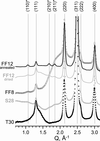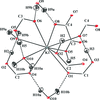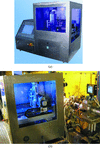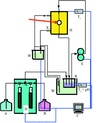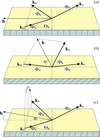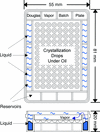issue contents
October 2008 issue

Cover illustration: Two-dimensional grazing-incidence X-ray scattering pattern for a PS-b-PI thin film deposited on a silicon substrate. Courtesy of Sangwoo Jin et al. [J. Appl. Cryst. (2007), 40, 950-958].
research papers
The crystal structure of colloidal particles in ferrofluids can be easily obtained in a fast synchrotron light diffraction experiment without any special treatment of the ferrofluid sample. Moreover, from the same diffraction patterns, parameters such as particle mean size and dispersion can be retrieved.
A neutron powder time-of-flight diffractometer for the FRM II reactor in Munich is described. It is expected to outperform existing diffractometers by at least an order of magnitude in data acquisition time.
Download citation


Download citation


It is shown that short-wavelength, helium cryostat synchrotron X-ray diffraction data of excellent quality can be measured in a very short time to high resolution using a large Mar CCD detector at the D3 beamline at Hasylab, DESY in Hamburg.
The stresses in cold rolled ferritic steel are measured both in a cold rolled material and under tensile loaded conditions. Plastic incompatibility second-order stresses and stored elastic energy are determined for different orientations of a polycrystalline grain, using X-ray diffraction data and results of the self-consistent elasto-plastic model.
A toolkit for the analysis of spin-echo small-angle neutron scattering measurements is presented. A wide range of samples and their expected signals are discussed.
Download citation


Download citation


The lattice parameters of Mg1−xFexO (x = 0.2, 0.3, 0.4) in the range P < 10.3 GPa and 300 < T < 986 K have been determined by time-of-flight neutron powder diffraction. Fitting all data simultaneously to a P–V–T–x equation of state leads to values for the temperature derivative of the isothermal incompressibility, ∂KT/∂T, and the isothermal Anderson–Grünseisen parameter, δT, of −0.024 (9) GPa K−1 and 4.0 (16) at 300 K.
A method for adapting spin echo scattering angle measurement to time-of-flight neutron sources is developed, tested and compared with traditional small-angle neutron scattering.
Open  access
access
 access
accessThe effect of nano-sized precipitates on the mechanical properties of boron-added low-carbon steels was studied by neutron scattering techniques such as powder diffraction, small-angle scattering and particle tracking autography.
Open  access
access
 access
accessAn automated sample changer for small-angle X-ray scattering (SAXS) on protein in solution is reported. The technical implementation and integration to a synchrotron-based SAXS beamline is described.
A circulating fluid flow cell is described for the in situ ultra-small-angle X-ray scattering study of solution-mediated systems. Results are presented for the real-time formation and growth from homogenous solution of nanocrystalline ceria that reveal new aspects.
A simple Monte Carlo model has been developed that convincingly reproduces the diffuse streaking that is observed on selected-area electron diffraction patterns of the rhombohedral phase of PZT. These results provide substantial evidence that the Pb as well as the Ti/Zr ions are displaced away from the centres of their coordination polydedra along cubic 〈111〉c directions and that these displacements are correlated along chains that run along 〈111〉c also.
The intensity contours of birefringence images for micropipes viewed end-on in 6H-SiC crystals have been derived based on Frank's theory.
It is shown through rigorous dynamical diffraction modeling that the ray tracing methods employed in kinematical diffraction analysis of strain become invalid for weakly deformed crystals that scatter in the dynamical limit. For an Si crystal illuminated by 12 keV X-rays, the kinematical formalisms should not be used if the strain gradient along the diffraction vector is smaller than 10−5 µm−1.
short communications
The average carbon number of paraffin and microcrystalline waxes has been determined by X-ray diffraction. The results compare well with those obtained by gas chromatographic analysis.
computer programs
Water Analysis Package is an updated computing and visualization server for the identification of water-mediated interactions in macromolecular structures.
A description is given of an algorithm in the software Tormat that allows the comparison of molecular conformations in an automated manner.
The first implementation of fitting X-ray Bragg diffraction profiles from strained multilayer crystals at a remote web-based X-ray software server is presented.
This database includes contact distances and geometry around metal sites in proteins derived from structures in the Protein Data Bank determined to a resolution of 2.5 Å or better. It can be accessed by SQL queries or by a user-friendly web interface.
laboratory notes
Open  access
access
 access
accessA procedure is presented for controlling the rate of evaporation during `microbatch under oil' protein crystallization.


 journal menu
journal menu








